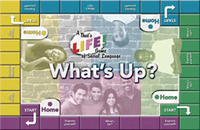What's Up? A That's LIFE! Game of Social Language
What's Up? A That's LIFE! Game of Social Language
Ages: 12-16
Grades: 7-11
Students role-play and practice what to say in social interactions and engage in short conversations with this language-based game for social skills. Adolescents love the strategy, fast pace, and competitive play in this game! Peer evaluation is integral to game-play—students use the thumbs up/thumbs down gesture to indicate how a player did with his response. Lots of discussion is sparked as students learn to identify appropriate responses in situations relevant to them.
Target these social language skills:
- Basic Nonverbal Communication—body language, voice, language style
- Problem-Solving and Decision Making—identify problems, choose the best alternative, evaluate decisions
- Conversation Skills—initiate conversations, turn-taking, topic maintenance, avoid interrupting, phone skills
- Emotions and Self-Esteem—saying how you feel, responding to others' emotions, respecting yourself
- Peer Relationships—giving compliments, asking for favors, disagreeing, joining groups, apologizing, responding to being left out
- Working With Others—getting along with adults, classroom survival skills, accepting differences in others, dealing with embarrassing situations
Social skill training is structured in three ways:
- That's Life! cards—the player expresses what he would say or do in a specific social situation: You think your friends tease your little brother too much. What could you say to them?
- Express yourself! cards—the player chooses a role-play partner for a brief interaction: I gave you a gift you don't like. Thank me for the gift.
- What's up? cards—the player chooses a conversation partner and conducts a brief social conversation: Choose a partner. Share your opinions about violence and safety issues at your school.
Students draw one of the cards and follow instructions with each move on the game board. Three hundred cards/social situations give students a wide variety of social language experiences for practice and discussion.
How To Play This Game
Game Play
- Having game players evaluate each other's responses provides natural practice in social interaction skills. Establish the criteria for evaluation before beginning the game. You can specify restricted targets, such as being polite or using appropriate eye contact, or encourage the players to take all components of social language skills into account, including tone of voice, nonverbal communication, clarity of message, appropriate respect for status, etc. Have the players use a thumbs-up or thumbs-down gesture to signal appropriate vs. inappropriate comments.
- Place each stack of cards facedown near the game board. Each player chooses a pawn color and places all four pawns of that color on the matching Start space. On each player's first turn, he rolls the die and moves one pawn from his Start space onto the game path the number of spaces shown.
-
If a player lands on an Express yourself! or a What's up? space, he
draws a card from the corresponding deck. If he lands on a blank space,
he draws a That's life! card. Each of these cards requires a different
type of social language interaction.
- That's life! cards—The player expresses what he would say or do in a specific social situation.
- Express yourself! cards—The player (Player A) chooses a role-play partner (Player B) for a brief interaction. Player B reads the card and evaluates Player A's response. If Player A's response is appropriate, he rolls the die again and moves accordingly. If his response is not appropriate, Player B explains the inadequacy and Player A returns his pawn to the space he occupied before the move. Player B switches one of her pawns with one of Player A's pawns.
- What's up? cards—The player (Player A) chooses a conversation partner (Player B) for a brief social conversation. Each non-participating player evaluates Player A's role-playing. If the majority signal thumbs up, Player A rolls the die again. Both Player A and Player B move one of their pawns accordingly. If the majority signal thumbs down, Player A returns to the space he occupied before the move. Player B keeps her pawns where they are. In case of a tie, Player A rolls the die. For an even number, Player A stays where he is and Player B moves one pawn ahead 2 spaces. For an odd number, Players A and B each move one pawn back 4 spaces.
- At the end of each turn, play passes to the player's left.
- If a player lands on a square occupied by an opponent, he sends his opponent's pawn back to its Start space. Players must roll the exact number to move a pawn into Home. Once a player's pawn is in Home, it can't be moved or sent back to Start by another player. If a player rolls a five, he may split the number to move two of his pawns.
Game Variations
- Limit each player to one, two, or three pawns.
- Set a time limit. The player with the most pawns in Home at the end of the time period wins.
- Set a timer for one minute and make general efficiency of a conversation part of peer evaluations.
- Videotape the game. Then have the players watch the tape and critique themselves. What would they like to have done differently? What did they learn from this observation?
COMPLETE KIT INCLUDES: 11" x 17" heavy-duty, single-fold game board; 300 cards on perforated card stock; instructions; 16 pawns; die; vinyl folder. (©1999)



